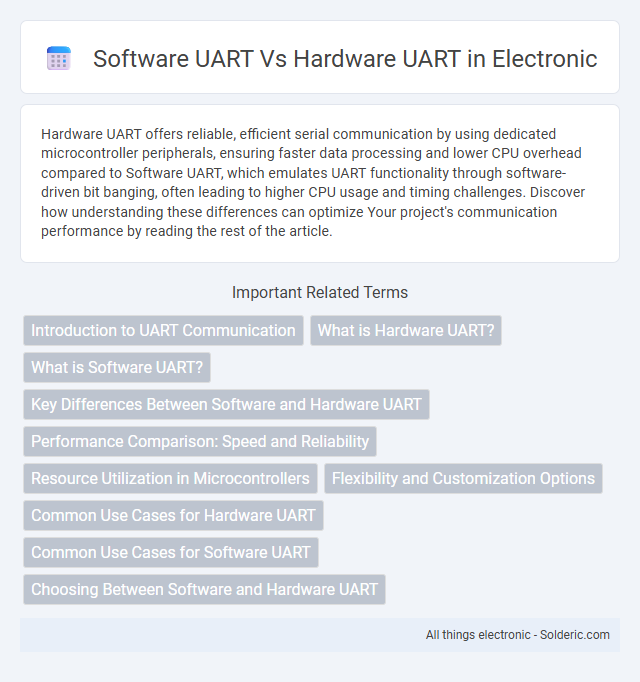Hardware UART offers reliable, efficient serial communication by using dedicated microcontroller peripherals, ensuring faster data processing and lower CPU overhead compared to Software UART, which emulates UART functionality through software-driven bit banging, often leading to higher CPU usage and timing challenges. Discover how understanding these differences can optimize Your project's communication performance by reading the rest of the article.
Comparison Table
| Feature | Software UART | Hardware UART |
|---|---|---|
| Implementation | Bit-banged code using GPIO pins | Dedicated UART hardware module |
| CPU Utilization | High, CPU handles timing and data | Low, UART module manages transmission |
| Speed | Limited, prone to timing errors at high baud rates | Supports high baud rates with accurate timing |
| Accuracy | Dependent on CPU interrupt handling | Highly accurate timing and data integrity |
| Hardware Requirement | No extra hardware required | Requires UART hardware peripheral |
| Availability | Can be implemented on any GPIO | Limited by microcontroller hardware |
| Complexity | Higher software complexity for timing | Lower software complexity |
| Use Cases | Low-speed communication, multiple UART emulation | High-speed, reliable serial communication |
Introduction to UART Communication
UART communication facilitates asynchronous serial data exchange using start, data, parity, and stop bits to ensure proper synchronization between devices. Hardware UART modules integrate dedicated circuitry within microcontrollers to handle data framing and timing, offering reliable and efficient communication with minimal CPU intervention. In contrast, Software UART relies on bit-banging techniques executed by the CPU, providing flexibility on pins without native UART support but often resulting in higher processing overhead and timing challenges.
What is Hardware UART?
Hardware UART is a dedicated microcontroller module designed to handle serial communication by converting parallel data into serial form and vice versa, enabling efficient asynchronous data transmission. It operates independently of the CPU, reducing processing overhead and supporting standard baud rates for reliable communication. This built-in hardware solution improves performance and timing accuracy compared to software-based UART implementations.
What is Software UART?
Software UART is a method of serial communication implemented entirely through software, using the microcontroller's general-purpose I/O pins to emulate UART protocol timing and data transmission. It offers flexibility by allowing UART functionality on pins without dedicated hardware support but requires precise timing control from the CPU, which can affect overall system performance. Your choice between Software UART and Hardware UART depends on resource availability and timing accuracy requirements in your embedded system design.
Key Differences Between Software and Hardware UART
Software UART emulates serial communication via software-driven timing, making it flexible but CPU-intensive and less reliable at high speeds. Hardware UART uses dedicated microcontroller modules to handle data transmission and reception, ensuring accurate timing, lower CPU load, and improved performance in demanding applications. Understanding these key differences helps you select the right UART type for your project's speed, resource, and reliability requirements.
Performance Comparison: Speed and Reliability
Hardware UART offers superior performance with higher data transfer speeds and enhanced reliability due to dedicated circuitry managing serial communication, minimizing CPU intervention and reducing timing errors. Software UART, relying on CPU-driven bit-banging, generally operates at lower speeds and can suffer from timing inaccuracies and increased CPU load, impacting overall system performance. For critical applications requiring consistent speed and reliable data transmission, hardware UART is the preferred choice.
Resource Utilization in Microcontrollers
Hardware UART modules in microcontrollers use dedicated communication peripherals, significantly reducing CPU load and enabling efficient, real-time serial data transmission with minimal intervention. Software UART relies on general-purpose I/O pins and CPU cycles, which increases processor overhead and limits multitasking capabilities, particularly in resource-constrained microcontrollers. For applications requiring high data rates or low power consumption, hardware UART is preferable due to its optimized resource utilization and timing accuracy.
Flexibility and Customization Options
Software UART provides greater flexibility and customization options by allowing developers to implement UART protocols directly in firmware, enabling adjustments to baud rates, data bits, and parity without hardware constraints. Hardware UART relies on dedicated peripheral circuits, offering limited configurability but consistent performance and offloading processing from the CPU. Choosing Software UART suits applications needing specific timing or protocol tweaks, while Hardware UART benefits systems requiring efficient, low-latency serial communication with minimal CPU intervention.
Common Use Cases for Hardware UART
Hardware UART is commonly used in embedded systems for reliable serial communication, such as connecting microcontrollers to GPS modules, Bluetooth devices, and serial peripherals. It provides precise timing and low CPU overhead, making it ideal for high-speed data transfers and real-time applications. Industrial automation and automotive systems often rely on hardware UART for robust and consistent data exchange.
Common Use Cases for Software UART
Software UART is commonly used in microcontroller applications where hardware UART peripherals are limited or already occupied, allowing flexible serial communication without additional hardware. It is ideal for low-speed data transmission in hobbyist projects, custom embedded systems, and cost-sensitive designs where minimizing component count is crucial. Software UART enables multi-protocol communication on devices with a single hardware UART, expanding connectivity options without hardware modification.
Choosing Between Software and Hardware UART
Choosing between Software UART and Hardware UART depends on system resource availability and timing precision requirements. Hardware UART offers reliable, low-latency data transmission with minimal CPU intervention, ideal for applications demanding consistent serial communication performance. Software UART provides flexibility and cost savings when hardware UART peripherals are limited but may introduce higher CPU overhead and timing variability.
Software UART vs Hardware UART Infographic

 solderic.com
solderic.com